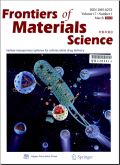In vitro evaluation of Zn–10Mg–xHA composites with the core–shell structure
Zinc-based composites represent promising materials for orthopedic implants owing to their adjustable degradation rates and excellent biocompatibility. In this study, a series of Zn–10Mg–xHA (x = 0–5 wt.
%) composites with the core–shell structure were prepared through spark plasma sintering, and their microstructural, mechanical, and in vitro properties were systematically evaluated. Results showed that the doped hydroxyapatite (HA) is concentrated at the outer edge of the MgZn2 shell layer. The compression strength of the Zn?10Mg?HA composite gradually decreased with the increase of the HA content, while its corrosion rate decreased initially and then increased. The corrosion resistance of the composite with the addition of 1 wt.% HA was improved compared to that of Zn–10Mg–0HA. However, the further increase of the HA content beyond 1 wt.
% resulted in a faster degradation of the composite. Moreover, the Zn–10Mg–1HA composite significantly enhanced the activity of MC3T3-E1 osteoblasts. Based on such findings, it is revealed that the composite containing 1 wt.
% HA exhibits superior overall properties and is anticipated to serve as a promising candidate for bone implant materials.
zinc-based composite、hydroxyapatite、mechanical property、in vitro degradation behavior、biocompatibility
18
2024-09-26(万方平台首次上网日期,不代表论文的发表时间)
共1页
240699






